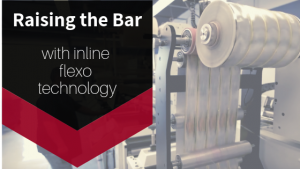Raising the Bar with Inline Flexo Press Technology
Across all verticals and industries, label and flexible packaging end-users are constantly looking for ways to increase their shelf visibility and enhance their products. A clear path to enhanced labels and packaging is through inline printing and embellishment completed with flexographic technology.
Read on for more on the various production paths converters can take to continue to add value to their existing or new flexo equipment.

Flexible Packaging
As this segment of packaging continues to develop momentum, growing nearly 3% in 2017, flexible packaging is proving to be a product vehicle that promotes growth for printers with the ability to offer it to their customers. That increase in book of business diversification is in response to the label industry not only following, but predicting consumer trends.
Why would end users drive the use of flexible packaging over rigid packaging? Lower shipping costs both to the producer and the consumer are accompanied by longer shelf-life of perishable items are just a few reasons flexible packaging is emerging as a viable solution to rigid packaging.
Lidding
As packaging evolves to include more flexible variations, lidding is seeing a reemergence as a profitable offering for converters. Lidding essentially is a material of choice (film, foil, paper, etc.) creating a seal over an opening, like single-serve coffee, yogurt or medicine.
The ability to produce die cut lidding on flexo equipment gives converters an opportunity to better maximize their capital asset investment. As traditional clamshell packaging begins to be replaced with lidding, the benefit of running these applications on existing narrow- to mid-web flexo technology is clear.
Extended Content
Extended content labels, or ECLs, are an excellent application choice for brands that want the ability to convey necessary information without interrupting their packaging design. Fortunately for converters, this design is easily navigable with the right flexo equipment.
From a configuration standpoint, having dedicated print stations to support a constant-tension unwind system and a constant-tension lamination system is a good place to start. Read more about retrofitting flexo equipment for ECLs here.
Tactile Finishes
Varnishes such as spot or flood varnishes can be used to give your label an expensive look without expensive production costs. Spot varnishing is where a varnish is applied to only part of the material where flood varnishing applies the finish to the entire label or package. Both are great options to increase the value of your label. Adding a varnish over your label presents several design advantages. Gloss, matte and satin finishes add a lush, tactile feel to your label, enticing customers through touch.
Customization and Unique Applications
Outside-of-the-box application requests are becoming more prevalent as converters work alongside OE manufacturers to best optimize their flexographic assets to win specific pieces of business. Additionally, increased SKUs and product variation have affected the production of highly-decorative, flexo-specific jobs, with an increasing number of mid- to wide-web converters seeking a cost-friendly way to maintain this growing business. Many are turning to productive, cost-efficient flexo presses for shorter, but permanent-run work as a solution.
What does this mean for converters? Printers often face one of two different scenarios:
- Potential customer bids out a new job
Adding customers to your book of business can mean one of two things: you’re either investing in additional equipment to accommodate the new jobs or you have an existing press that has the bandwidth to run the proposed work. When it comes to labels or packaging that requires new equipment, be prepared to complete an ROI even if new equipment or retrofits are needed.
2. Current customer bids out a new job
When a customer has a need for a new label to be produced, that job will likely be bid out to their current converter, along with possible competitors. A simple ROI including the cost of the retrofits needed and cost to produce the label can indicate whether or not a printer should consider the job. Keep in mind that the current work could also be at jeopardy if a customer moves some work to a competing printer. It’s not uncommon for end-users to bundle production to ensure that they are getting the best prices for each of their jobs.
With embellished and complex construction highly embellished labels, there may even be a case for a new press to be engineered specifically to the jobs if the margins support a new flexo press investment.
To maximize a future investment of flexo capital equipment, there is no denying that a press must be able to support applications as your client requests change and client base grows. Ideally, a printing solution that tackles labels, film, shrink sleeves, flexible packaging and foil lidding with the ability to print high-end embellishments is imperative to remain competitive as the future of flexo continues to expand.
With more than 1,000 presses installed worldwide, users report 60% faster job changeovers and 50% less waste. Averaging less than 2 minutes for ink and plate changeovers and under 30 seconds for die changes coupled with the most efficient web paths, Mark Andy Performance Series E offers the performance you want and everything you need in flexo technology. Learn more about the Performance Series Platform here.